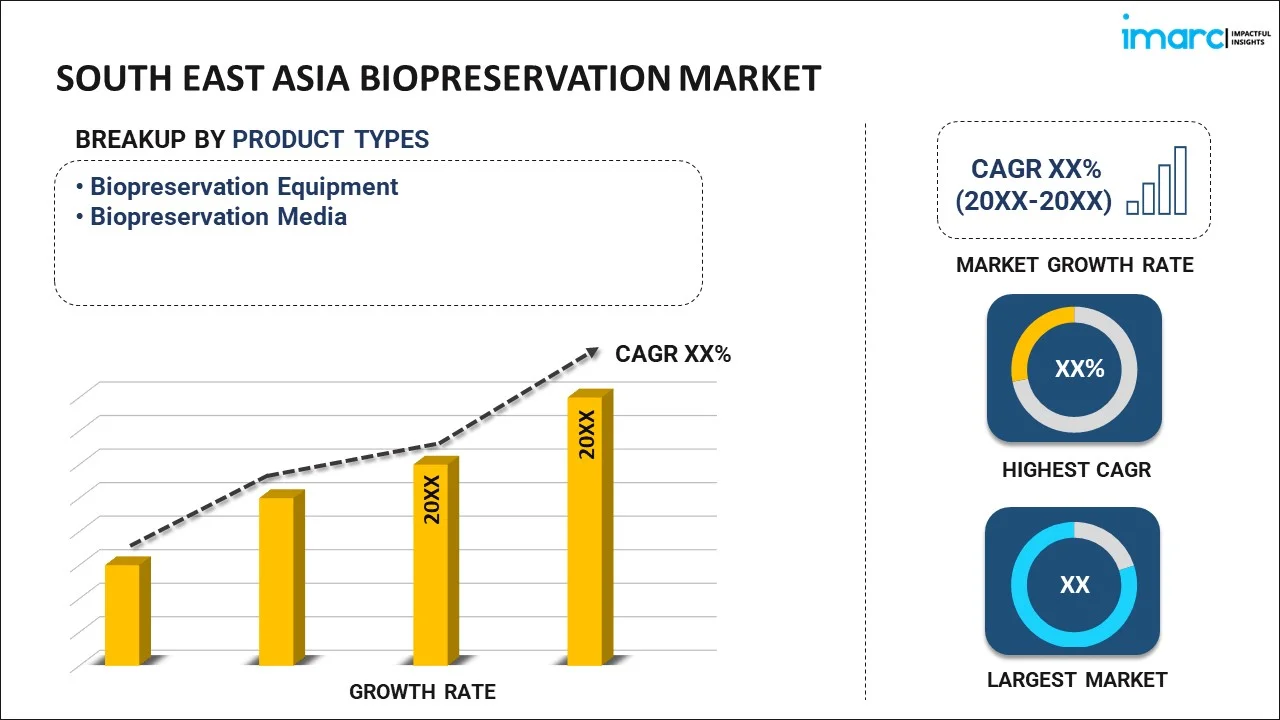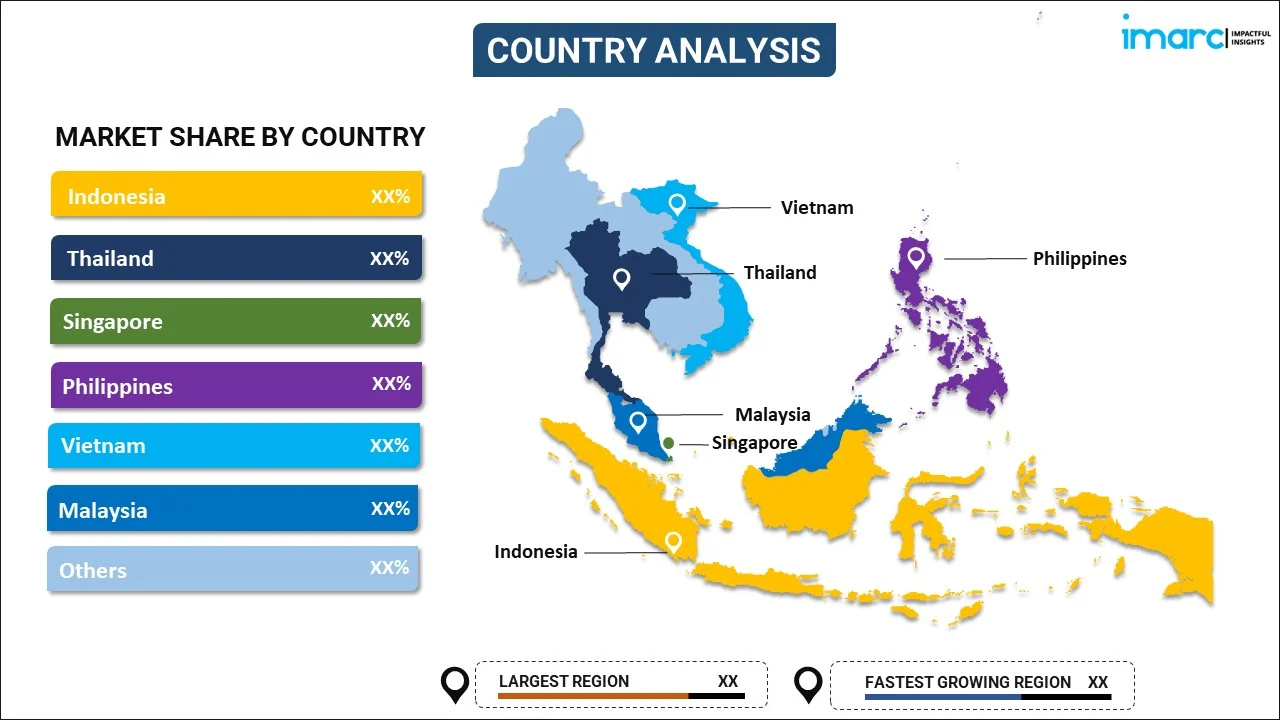
South East Asia Biopreservation Market Report by Product Type (Biopreservation Equipment, Biopreservation Media), Application (Therapeutic Applications, Biobank Applications, Drug Discovery Applications), and Country 2025-2033
Market Overview:
The South East Asia biopreservation market size reached USD 318.2 Million in 2024. Looking forward, IMARC Group expects the market to reach USD 1,076.0 Million by 2033, exhibiting a growth rate (CAGR) of 14.50% during 2025-2033. The growing prevalence of chronic diseases such as cancer, diabetes, and cardiovascular disorders, the widespread adoption of biopreservation in the pharmaceutical industry, and the growing biomedical research and development (R&D) activities represent some of the key factors driving the market.
|
Report Attribute
|
Key Statistics
|
|---|---|
|
Base Year
|
2024
|
|
Forecast Years
|
2025-2033
|
|
Historical Years
|
2019-2024
|
|
Market Size in 2024
|
USD 318.2 Million |
|
Market Forecast in 2033
|
USD 1,076.0 Million |
| Market Growth Rate 2025-2033 | 14.50% |
Biopreservation, also known as biological preservation or cryopreservation, is an essential process used in various fields, such as medicine, biotechnology, and research, to store biological materials, such as cells, tissues, organs, or entire organisms, at low temperatures to maintain their viability and functionality for an extended period. It prevents the degradation and death of these biological materials, allowing them to be stored for future use, analysis, or research. It extends the shelf life of biological samples by cooling these samples to sub-zero temperatures, typically at or below -196 degrees Celsius or -321 degrees Fahrenheit, using techniques such as liquid nitrogen or controlled-rate freezers, which slow down biological activities dramatically. It minimizes cellular damage and metabolic processes, effectively pausing the biological materials in a state of suspended animation. It offers several applications across various fields, including medicine, biotechnology, the food industry, research, and biodiversity conservation. Additionally, biopreservation is essential for storing human tissues and organs for transplantation and allows organs to be matched with recipients, reducing the risk of rejection and increasing the chances of successful transplantation. Consequently, biopreservation can maintain the integrity of biological materials and transform numerous fields by facilitating advancements in medical treatments, biotechnology research, and conservation efforts.
South East Asia Biopreservation Market Trends:
The market is primarily driven by the rising number of chronic diseases such as cancer, diabetes, and cardiovascular disorders. In addition, the increasing demand for biopreservation to store biological samples that are critical for understanding the molecular basis of these diseases, developing new therapies, and conducting clinical trials, thus influencing the market growth. Moreover, the widespread adoption of biopreservation in the pharmaceutical industry for manufacturing and clinical trials represents another major growth-inducing factor. Also, biopreservation ensures the integrity of biological materials used in drug discovery and development, including cell-based assays and drug screening which led pharmaceutical companies to invest in advanced biopreservation solutions to maintain sample quality, thus augmenting the market growth. Besides this, several governments and private investors in South East Asia are focusing on expanding healthcare infrastructure, including hospitals and research facilities, which are increasing the need for biopreservation solutions to ensure the long-term viability of biological samples in these institutions, accelerating market growth. Along with this, the growing awareness regarding personalized medicine, which are tailored medical treatments for individual patients based on their genetic makeup, thus propelling the market growth. It is also essential for storing patient samples, such as DNA and tissues, used in personalized medicine applications. Furthermore, the growing biomedical research and development (R&D) activities are integral to maintaining the viability of biological specimens used in research, including stem cells, tissues, and genetic materials, which ensure the long-term stability of these samples, thereby creating a positive market outlook.
South East Asia Biopreservation Market Segmentation:
IMARC Group provides an analysis of the key trends in each segment of the market, along with forecasts at the regional and country levels for 2025-2033. Our report has categorized the market based on product type and application.
Product Type Insights:

- Biopreservation Equipment
- Biopreservation Media
The report has provided a detailed breakup and analysis of the market based on the product type. This includes biopreservation equipment and biopreservation media.
Application Insights:
- Therapeutic Applications
- Biobank Applications
- Drug Discovery Applications
A detailed breakup and analysis of the market based on the application have also been provided in the report. This includes therapeutic applications, biobank applications, and drug discovery applications.
Country Insights:

- Indonesia
- Thailand
- Singapore
- Philippines
- Vietnam
- Malaysia
- Others
The report has also provided a comprehensive analysis of all the major regional markets, which include Indonesia, Thailand, Singapore, Philippines, Vietnam, Malaysia, and Others.
Competitive Landscape:
The market research report has also provided a comprehensive analysis of the competitive landscape. Competitive analysis such as market structure, key player positioning, top winning strategies, competitive dashboard, and company evaluation quadrant has been covered in the report. Also, detailed profiles of all major companies have been provided.
South East Asia Biopreservation Market Report Coverage:
| Report Features | Details |
|---|---|
| Base Year of the Analysis | 2024 |
| Historical Period | 2019-2024 |
| Forecast Period | 2025-2033 |
| Units | Million USD |
| Scope of the Report | Exploration of Historical Trends and Market Outlook, Industry Catalysts and Challenges, Segment-Wise Historical and Future Market Assessment:
|
| Product Types Covered | Biopreservation Equipment, Biopreservation Media |
| Applications Covered | Therapeutic Applications, Biobank Applications, Drug Discovery Applications |
| Countries Covered | Indonesia, Thailand, Singapore, Philippines, Vietnam, Malaysia, Others |
| Customization Scope | 10% Free Customization |
| Post-Sale Analyst Support | 10-12 Weeks |
| Delivery Format | PDF and Excel through Email (We can also provide the editable version of the report in PPT/Word format on special request) |
Key Questions Answered in This Report:
- How has the South East Asia biopreservation market performed so far and how will it perform in the coming years?
- What has been the impact of COVID-19 on the South East Asia biopreservation market?
- What is the breakup of the South East Asia biopreservation market on the basis of product type?
- What is the breakup of the South East Asia biopreservation market on the basis of application?
- What are the various stages in the value chain of the South East Asia biopreservation market?
- What are the key driving factors and challenges in the South East Asia biopreservation?
- What is the structure of the South East Asia biopreservation market and who are the key players?
- What is the degree of competition in the South East Asia biopreservation market?
Key Benefits for Stakeholders:
- IMARC’s industry report offers a comprehensive quantitative analysis of various market segments, historical and current market trends, market forecasts, and dynamics of the South East Asia biopreservation market from 2019-2033.
- The research report provides the latest information on the market drivers, challenges, and opportunities in the South East Asia biopreservation market.
- Porter's five forces analysis assist stakeholders in assessing the impact of new entrants, competitive rivalry, supplier power, buyer power, and the threat of substitution. It helps stakeholders to analyze the level of competition within the South East Asia biopreservation industry and its attractiveness.
- Competitive landscape allows stakeholders to understand their competitive environment and provides an insight into the current positions of key players in the market.
Need more help?
- Speak to our experienced analysts for insights on the current market scenarios.
- Include additional segments and countries to customize the report as per your requirement.
- Gain an unparalleled competitive advantage in your domain by understanding how to utilize the report and positively impacting your operations and revenue.
- For further assistance, please connect with our analysts.
 Inquire Before Buying
Inquire Before Buying
 Speak to an Analyst
Speak to an Analyst
 Request Brochure
Request Brochure
 Request Customization
Request Customization




.webp)




.webp)












